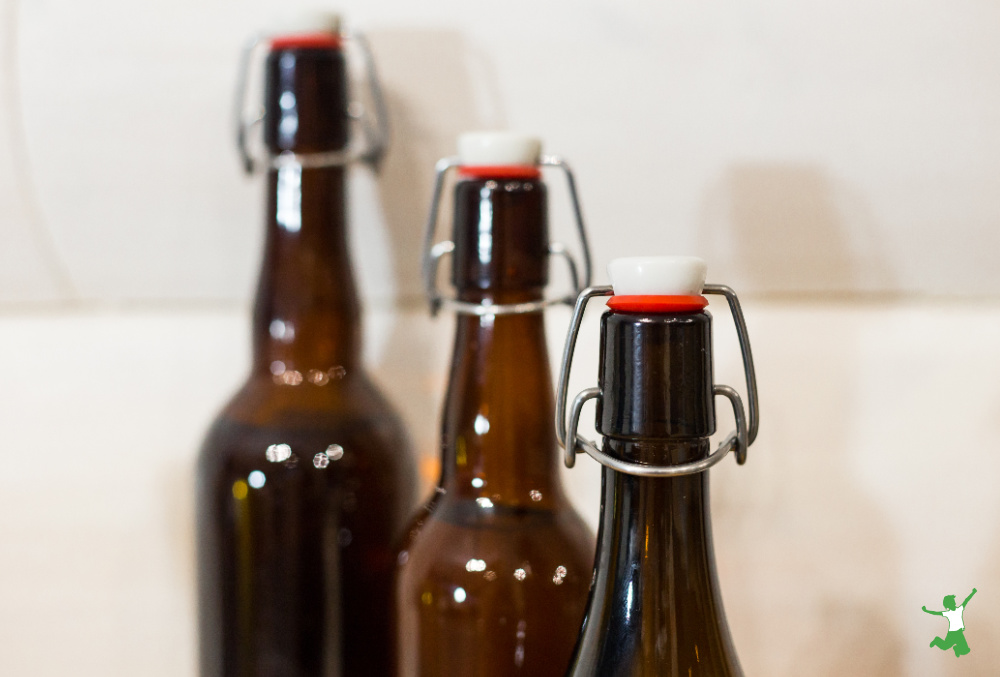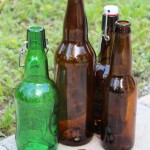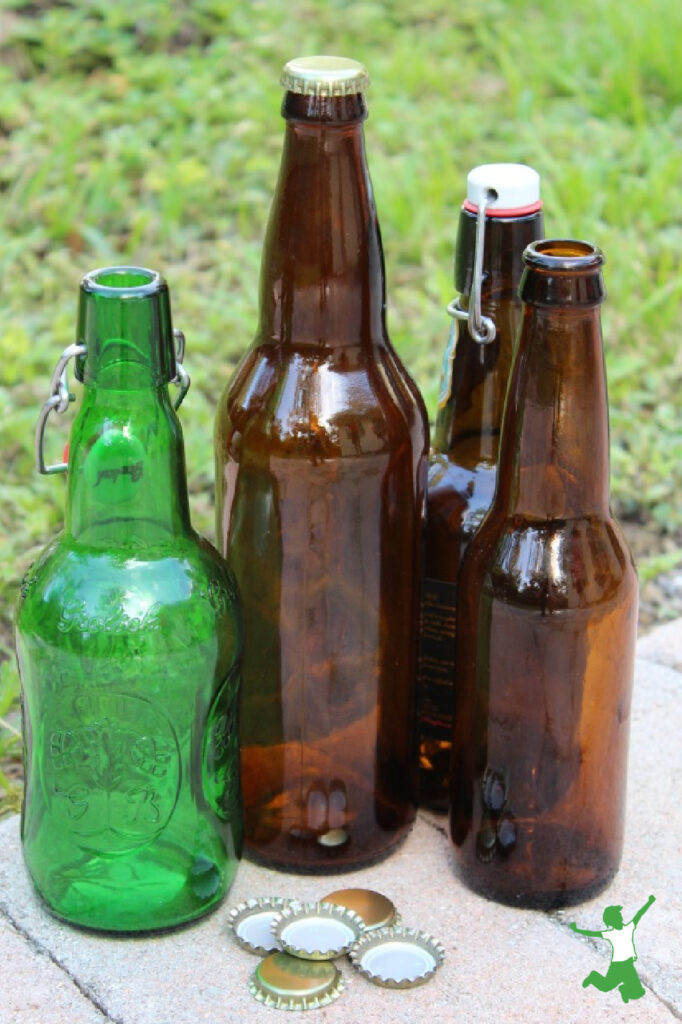Table of Contents[Hide][Show]
How to bottle homemade fermented beverages for extra carbonation, bubbles, and fizz on par with commercial sodas. This secondary fermentation provides extra probiotics and enzymes too!

If you’ve been reading this blog for any length of time, you know that I am a big advocate of probiotic fermented beverages.
A survey of ethnic drinks from around the world reveals that enjoyment of the unique, health-boosting refreshment furnished by traditionally fermented beverages is nearly universal.
These drinks are the healthy sodas of old, minus the additives, chemicals, GMO high fructose corn syrup, and artificial colors and flavors.
Plain water pales in comparison to the effective manner in which a homemade soda or fermented drink quenches thirst after a sweaty round of yard work, exercise, or adventure in the outdoors through rapid replacement of lost electrolytes.
Traditional beverages also promote the thorough digestion of food by supplying additional enzymes when sipped with meals.
When carefully made with quality ingredients, alcoholic fermentation is replaced with lacto-fermentation with complex flavors and a slight effervescence the enjoyable result.
With nearly all ancestral cultures boasting at least one delicious, artisanal fermented beverage made from the local bounty of the fields, the modern addiction to sugar and synthetically sweetened sodas suggests that our desire for a bubbly drink is a most basic and primal need.
Homemade fermented beverages are indeed the answer to the modern addiction to soda!
Primary Fermentation
If you haven’t yet embarked on a fermented beverage adventure in your kitchen, there are numerous how-to’s on this blog to help you get started or expand your repertoire as needed.
Here are a few of the recipes and video lessons I’ve posted over the years to give you some ideas:
- Hindu Lemonade
- Switchel
- Beet Kvass
- Orangina (fermented orange juice)
- Water Kefir
- Basic Homemade Kombucha
- Ginger Ale
- Advanced Kombucha Brewing
- Root Beer
Extra Carbonation
While all of these beverages will yield a satisfying, slightly effervescent drink, some people find that they want more fizz.
This is especially the case for those attempting to break a commercial soda habit.
This is possible, but an extra step…bottling…is necessary to produce extra carbonation.
Bottling is a secondary fermentation that adds not only high levels of fizz, but extra probiotics and enzymes too!
This will achieve a level of bubbliness comparable to store soda.
A successful secondary fermentation involves knowing:
- Where to find the right bottles
- How much to fill them
- How long to leave them on the counter
- Safe opening without an explosion and a big mess.
Note that you should only consider bottling after the initial fermentation process is complete.
In other words, bottling is an extra step to achieve extra fizz and probiotics if desired.
In other words, secondary fermentation of cultured beverages is not necessary if you are already enjoying your homemade drinks just the way they are.
Pressed for time?
Try this 5-minute homemade soda recipe that my son invented and taste-tested as his school Science Fair project!

How to Bottle Fermented Beverages
How to bottle homemade fermented beverages for extra carbonation and fizz on par with commercial sodas.
Ingredients
- 2 quarts homemade fermented beverage see list above for ideas
Equipment
- 8 12-ounce homebrew bottles
- 8 bottle caps and capper
- 8 swing top bottles with attached cap optional (if above equipment is not available)
Instructions
-
Thoroughly wash and dry homebrew bottles with warm soapy water. Do not use the dishwasher.
-
Fill each 12 ounce homebrew bottle two-thirds full (about 8 ounces). In other words, do not fill beyond the lower neck of the bottle. This leaves ample room for carbonation so the bottles don’t explode and blow off the caps!
-
Attach bottle caps with capper -OR- secure caps on swing top bottles securely.
-
Leave on the kitchen counter for 2 days.
-
Refrigerate for a full day to make sure each bottle is very, very cold.
-
Open each bottle only when very cold and crack each cap slowly to gradually release the pressure from the carbonation without making a mess. I recommend opening the bottles in your kitchen sink.
Recipe Video









I admit I love fizzy drinks sometimes, but know how dangerous soda is to your health so I avoid it. Now I might have to try this homemade soda.
In Mexico, where my family is from, they make tejuino, which is a fermented corn drink with various different spices added to it. Once the drink has fermented, they squeeze green lemons and some salt…sooooooooo delicious!!
Mine ALWAYS looks bubbly (Kombucha, Water Kefir, Ginger Soda) but NEVER tastes bubbly. Even with bottling. Even with adding some extra sugar (to the WK). It’s such a huge bummer.
Ora Wellness site on June 6, 2013 posted an article saying that Kombucha has large amounts of fluoride in it. Just wanted to know what your thoughts are about this. Also is using paper towels to cover the kombucha (in skinnier jars) OK to use instead of the white cotton towels?
I love homemade sodas, kombucha, etc. and don’t have any problems getting it fizzy enough. However, they need to be refrigerated in order to stop the fermenting, and that’s where I run into problems. My refrigerator isn’t big enough to store even a two-day supply (one bottle per person per day) of soda for my family. Do y’all have a separate refrigerator just for your homemade sodas?
Sarah,
I really like your blog when you are talking about traditional foods or videos so today was great.
Your expertise has helped me so much in my whole real tradtional foods journey.
Thank You Thank You! And keep up the good work!
Thanks for this info! My komboocha really varies with its fizz– some batches are great, others very little. I am wondering about a recent post from the Oralwellness people who have said they have stopped drinking komboocha because of the high flouride content. What is your take on this? I also do not know if natural flouride acts differently than the industrial stuff that is put in our water supplies. Oralwellness even went as far as to say that they have experienced real dental deterioration with patients who have started consuming komboocha.
I recently read an article regarding kambucha having high amounts of both fluoride and aluminum. Has anybody else heard about this? I love my kombucha and drink quite a bit.
Here’s my take on that. https://www.thehealthyhomeeconomist.com/fluoride-in-kombucha-should-you-be-concerned/
Great work Sarah! I was kinda surprised to see that you didn’t add any more sugar to the 2nd fermentation. I have been adding about a 1/2t. of coconut sugar to the bottle to aid in the secondary ferm…is this something you recommend or not?
Sometimes I have better luck than other times with bubbles. My kombucha isn’t getting too fizzy anymore, also I haven’t been liking the taste of it recently, not sure what’s going on there. But I made apple cider from Nourishing Traditions recently. You juice apples and add whey and sea salt and leave it on the counter for about three days. Then I strained it and put it in the fridge. I used old 64 oz plastic juice jugs (I know it’s a no no for plastic but all my glass was in use and I had nothing else large enough). I left them in the fridge for a while and when I opened it half of it was bubbles and foam. That has been the fizziest thing I have made by far, and it happened in the fridge! I still want to try hindu lemonade.